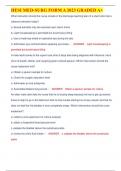, TOTAL
ASSESSMENT
Chapter 1
GUIDE
Exploring Child Development
Topic (A-head) Factual Conceptual Applied
Defining the Multiple Choice 1, 3, 4, 6, 8, 10–15, 19, 21, 25, 26 5, 7, 9, 18, 20, 22, 23,
Field 24, 27, 29 28
True/False 1
Short Answer 1, 2
Essay 3 1, 2
Theories of Child Multiple Choice 16, 17, 33, 35–38, 42, 2, 30, 32, 34, 41, 51, 31, 39, 40, 43, 45, 46,
Development 44, 47–50, 52, 57, 61– 53–55, 64, 70, 73, 78, 56, 58–60, 65, 66, 71,
63, 67–69, 74–77, 80– 84, 86, 87, 97, 99, 102– 72, 79, 83, 94, 100, 105
82, 85, 88–93, 95, 96, 104, 106
98, 101
True/False 2–4, 6, 8–10, 12–14 5, 11 7
Short Answer 3, 4, 6–8 5
Essay 4 5 6
Research in Child Multiple Choice 107, 109, 117, 121, 124, 108, 110, 111, 118, 119, 112–116, 120, 123,
Development 125, 135, 137–139, 142– 122, 126, 129, 131, 136, 127, 128, 130, 132, 145
144, 148 140, 141, 146, 147, 149
True/False 16 15, 17, 18
Short Answer 9, 10, 11
Essay 8 7
Applications and Multiple Choice 134 133
Careers Related to
Children
True/False 19
Short Answer
Essay
2
,CHAPTER 1 EXPLORING CHILD DEVELOPMENT
1.1 Multiple-Choice Questions
1.1-1) The field of study in which researchers from many disciplines work to describe and understand physical,
cognitive, and social changes in children as they grow is called _______________.
A) psychology
B) psychoanalysis
C) child development
D) socioemotional development
Difficulty: 1
Question ID: 1.1-1
Page Ref: 2
Topic: Defining the Field
Skill: Factual
Answer: C) child development
1.1-2) Theories act as filters for identifying relevant information, observations, and relationships. This means that
they _______________.
A) determine how far children can develop
B) influence the kinds of questions that researchers ask about development
C) help explain biases in thinking and acting
D) shape the beliefs and values of each culture
Difficulty: 2
Question ID: 1.1-2
Page Ref: 8
Topic: Theories of Child Development
Skill: Conceptual
Answer: B) influence the kinds of questions that researchers ask about development. Theories highlight important
aspects of development and draw attention to specific influences.
1.1-3) What are the 3 primary facets or components of development?
A) physical, cognitive, and socioemotional
B) cognitive, socioemotional, and behavior genetics
C) socioemotional, behavior genetics, and cultural
D) physical, cognitive, and cultural
Difficulty: 1
Question ID: 1.1-3
Page Ref: 3
Topic: Defining the Field
Skill: Factual
Answer: A) physical, cognitive, and socioemotional
1.1-4) Which of the following is an example of physical development?
A) communication and language
B) attachment to the primary caretaker
C) growth of the brain and nervous system
D) improvements in long-term memory
Difficulty: 1
Question ID: 1.1-4
Page Ref: 3
Topic: Defining the Field
Skill: Factual
Answer: C) growth of the brain and nervous system
Copyright © 2014, 2010, 2007 by Pearson Education, Inc. All rights reserved. 3
, Chapter 1: Exploring Child Development
1.1-5) Shortly after birth, Terrell could not even hold his head up, but just a few months later, he can hold his head
up and roll over from his back to his stomach. These advances in Terrell’s muscle strength and coordination are
examples of _______________.
A) physical development
B) cognitive development
C) socioemotional development
D) child development
Difficulty: 2
Question ID: 1.1-5
Page Ref: 3
Topic: Defining the Field
Skill: Applied
Answer: A) physical development. Motor skill acquisition is an aspect of physical development.
1.1-6) Changes in how children think, remember, and communicate is called _______________.
A) physical development
B) cognitive development
C) socioemotional development
D) child development
Difficulty: 1
Question ID: 1.1-6
Page Ref: 3
Topic: Defining the Field
Skill: Factual
Answer: B) cognitive development
1.1-7) Francisco does well in school, and in particular, he enjoys math and science classes. Intellectual skills such as
memory, problem solving, and logic that are practiced in classes such as these are part of _______________
development.
A) socioemotional
B) cultural
C) physical
D) cognitive
Difficulty: 1
Question ID: 1.1-7
Page Ref: 3
Topic: Defining the Field
Skill: Applied
Answer: D) cognitive. Cognitive development includes skills such as memory, problem solving, and logic.
1.1-8) Socioemotional development is best described as how _______________.
A) children interact with other people
B) children view themselves
C) one society views children from a different society
D) society molds the emotions of children
Difficulty: 1
Question ID: 1.1-8
Page Ref: 3-4
Topic: Defining the Field
Skill: Factual
Answer: A) children interact with other people
1.1-9) Amy is going through a “lanky” period of development. This indicates that _______________.
A) she is thin due to malnutrition
B) she is tall as she exercises a lot
C) she has unusually long limbs
Copyright © 2014, 2010, 2007 by Pearson Education, Inc. All rights reserved. 4



